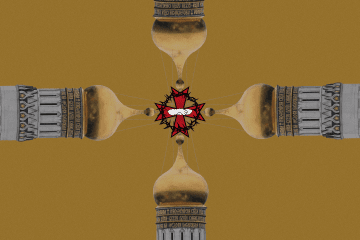- Category
- World
How Tight Is Putin’s Grip on Latin America Becoming?
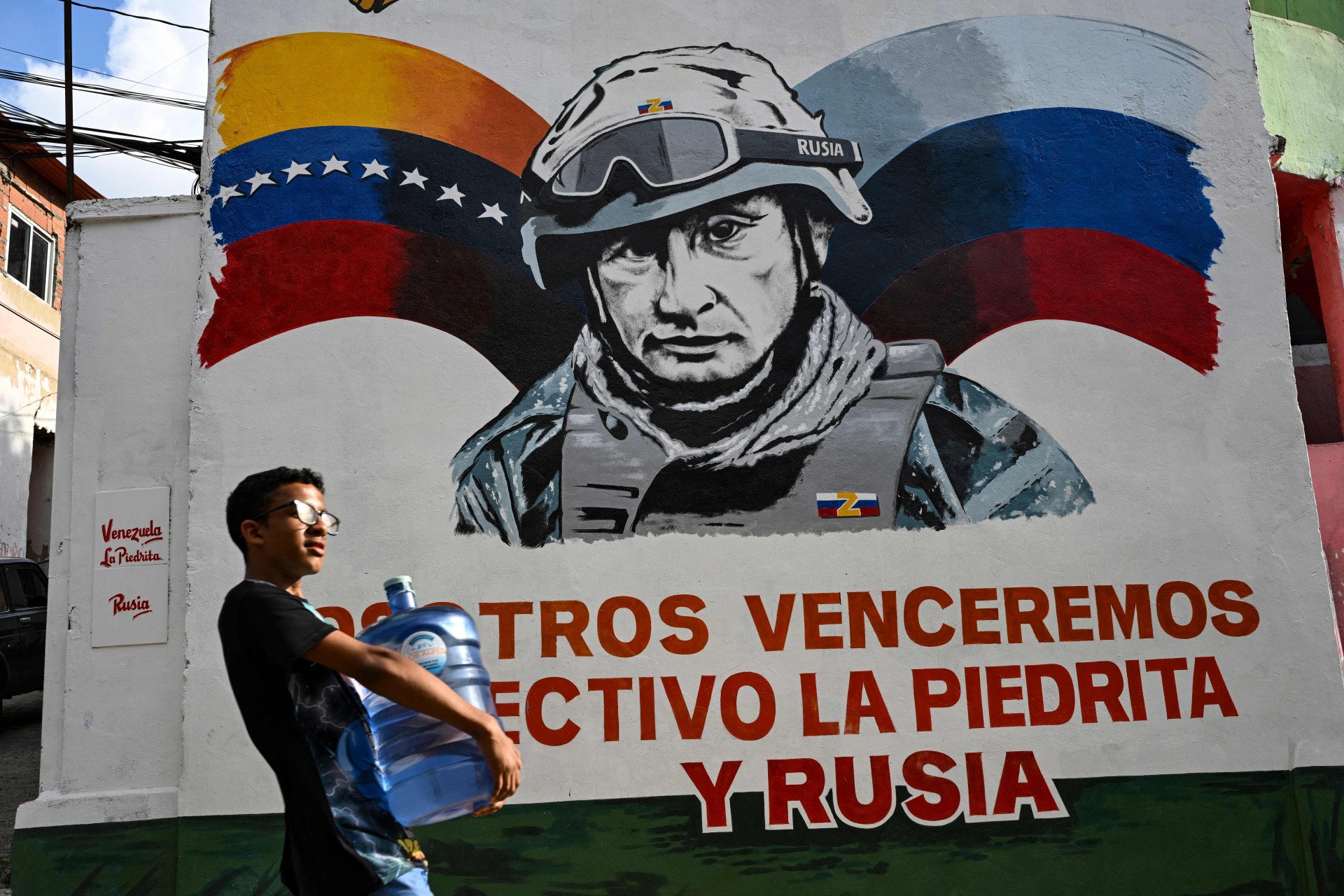
Russia is expanding its presence in Latin America through hybrid tactics that blend military, cyber, and information operations.
Russian leader Vladimir Putin and Venezuelan leader Nicolás Maduro signed a 10-year strategic cooperation agreement on May 7, strengthening their alliance, covering military-technical, space, and aviation collaboration, to “closely fight against international terrorism and extremism” while opposing sanctions placed against them.
The pact further cements Maduro’s open support for Russia’s war against Ukraine, saying that “Russia will emerge united and victorious from this battle.”
Russia has long been active in Latin America, but since it invaded Ukraine in 2022, experts have warned of growing Kremlin influence across the region and the impact on global security. On May 9, Russian Foreign Minister Sergey Lavrov marked 65 years of “brotherhood” with Cuba during Moscow’s Victory Day parade, praising Havana’s loyalty amid the “hybrid war being waged by the West.”
Russia was already Latin America’s top arms supplier by 2016, and it’s only grown since then. Today, the Kalashnikov factory is under construction in Venezuela, and Rosoboronexport—the state arms exporter—confirmed plans to produce weapons regionally and open a helicopter maintenance hub in Peru.
Experts, like Douglas Farah say that Russia is “establishing a multisector, persistent presence” in the region and aggressively implementing hybrid warfare to counter NATO.
Analysts see this escalation as a calculated show of force aimed at Western nations supporting Ukraine. Luis Fleischman warns that authoritarian regimes in Nicaragua, Venezuela, Cuba, and Bolivia are “practically surrendering their countries” to Moscow’s influence, “forming a bloc that challenges democracy and peace.”
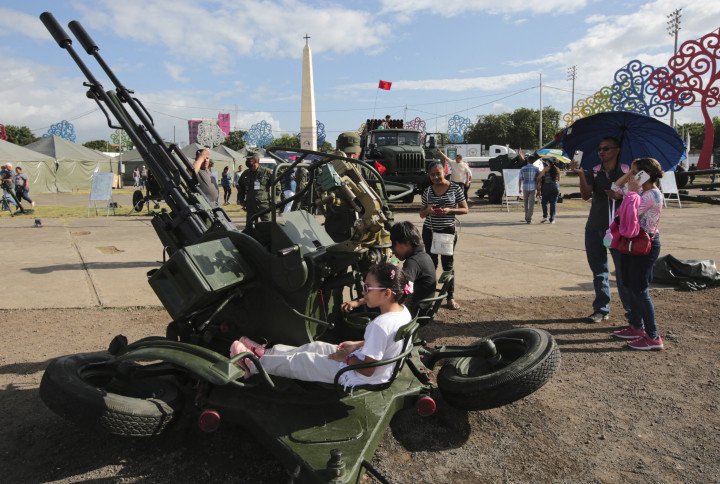
Who are Russia’s strongest Latin American Allies?
Russia’s involvement within Latin American countries varies, from political, ideological, and economic alliance, to a more utilitarian choice, as Farah wrote in his report, Dangerous Alliances: Russia’s Strategic Inroads in Latin America.
Russia has three primary Allies: Venezuela, Cuba, and Nicaragua, which Farah reports are radical populist authoritarian governments that consistently support the Kremlin in its invasion of Ukraine. They have “nearly identical templates to Russia,” by suppressing opposition, abolishing judicial independence, silencing dissent, and manipulating elections.
While some Latin American countries remain neutral, few have condemned Russia’s invasion of Ukraine. Chile, Ecuador, and Colombia are “dangerously uninformed and unaware of Russian strategic activities and operations in their countries,” Farah reported.
The Russian military is most active in Nicaragua, under President Daniel Ortega and his wife and Vice President Rosario Murillo. It is one of the first countries to support Russia’s occupation of Ukraine’s eastern regions. Nicaragua was also one of the few countries to back Russia’s recognition of the breakaway Georgian regions of Abkhazia and South Ossetia, a stance echoed by Venezuela and Cuba, while other world leaders criticized Russia.
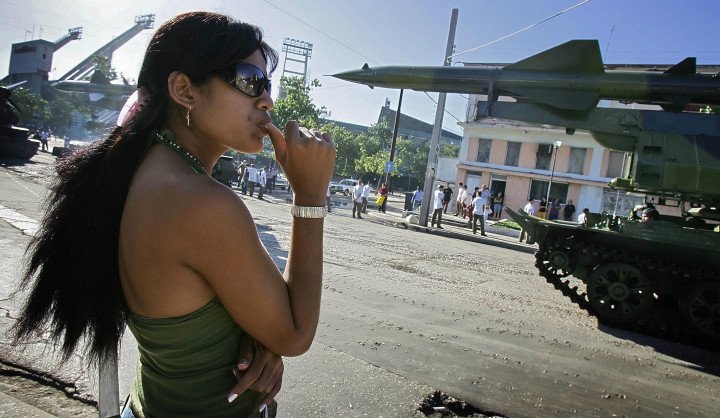
Russian cyber warfare in Nicaragua
Russia’s military cooperation with Nicaragua is at an all-time high, giving Moscow a strategic foothold in Central America. Over the past decade, more than 3,500 Russian troops have entered the country, with around 250 believed to be stationed there permanently.
Following Russia’s invasion of Ukraine in 2022, Nicaragua renewed a decree allowing joint military exercises with Russian forces. Former US Assistant Secretary of State Brian Nichols called the move a “provocation” by the Nicaraguan regime.
Nicaragua hosts Russia’s GLONASS satellite navigation system, which is capable of cyber and electronic intelligence operations. Farah reported that the country also houses a multimillion-dollar “vaccination plant” that produces no vaccines but is a Russian cyber warfare and training center with the diplomatic status of an embassy.
Moscow’s surveillance systems in Latin America are “among the most sophisticated in the world,” according to Jack D. Gordon at the Institute for Public Policy at Florida International University (FIU).
Surveillance technologies are often run by Russian intelligence officials only, and the Nicaraguan military is limited to securing the areas.
They allow Russia access to military, law enforcement, and financial data in multiple countries in Latin America, Gordon says. Since 2017, their use has empowered the most repressive regimes, while projecting the Kremlin as a relevant global actor.
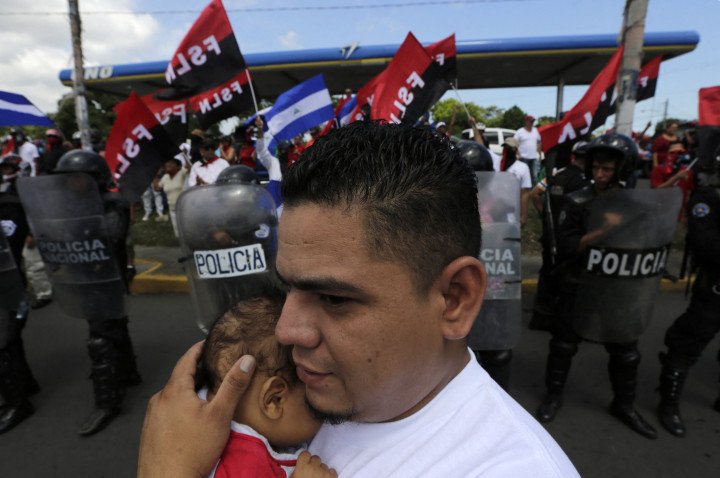
At Nicaraguan Mokorón military base, which works as a Russian espionage centre, Russian-operated SORM-3 surveillance tech reportedly helped Nicaraguan authorities identify anti-government protestors in 2018, killing over 350 unarmed civilians in what the regime called “Operation Clean-up”.
The Ortega regime used military-grade lethal weapons, including AK-type rifles, sniper rifles, machine guns, and portable anti-tank rocket-propelled grenade launchers, and the RPG-7, according to an Amnesty International investigation.
Moscow’s goal is to break the hemispheric values…and replace them with a toxic mix of anti-democratic values, state corruption, and populism based on authoritarian models, and they will not rest until they achieve it.
In 2016, Russia sent 20 T-72B tanks, helicopters, and anti-aircraft systems to Nicaragua.
In 2024, due to Nicaragua’s “heightened collaboration with Russia, particularly in support of Russia’s invasion of Ukraine,” the US Department of Commerce placed an arms embargo on the nation, halting all defense-related exports.
In 2025, Nicaragua confirmed it had received another Russian delivery: five Mi-17 helicopters, three Antonov AN-26 transport aircraft, and 18 ZU-23-2 air defense systems—despite limited military funding. This triggered speculation about Russia’s terms of the deal.
Russia’s weapons and private military companies in Venezuela
Venezuela is Russia’s leading arms customer in Latin America, their relationship involves military sales, intelligence cooperation, joint military exercises, and strategic partnerships.
Since the early 2000s, Moscow has sold over $11.4 billion in weapons to Caracas, including Su-30 fighter jets, T-72 tanks, S-300 air defense systems, Mi-17 and Mi-35 helicopters, AK-103 rifles, naval platforms, and surface-to-air missiles.
Every five years since 2008, Russia has sent nuclear-capable Tu-160 bombers to Venezuela, underscoring the depth of military ties.
Experts reported Maduro’s regime was near collapse in 2019 but survived in part thanks to support from malign actors such as Russia.
Russian private military companies (PMCs), active in Venezuela since 2017, have become key tools in Moscow’s global influence strategy. Russian PMCs were used as a proving ground in Ukraine; since then, they’ve multiplied worldwide.
In 2019, amid the Trump administration's calls to oust Maduro, Russia reportedly deployed around 100 PMCs to protect the regime. Wagner Group PMC was seen alongside Venezuelan police during protests over disputed elections.
PMCs are believed to provide security for the country's high-ranking officials while conducting cyber and surveillance operations, reinforcing Russia’s foothold in Venezuela.
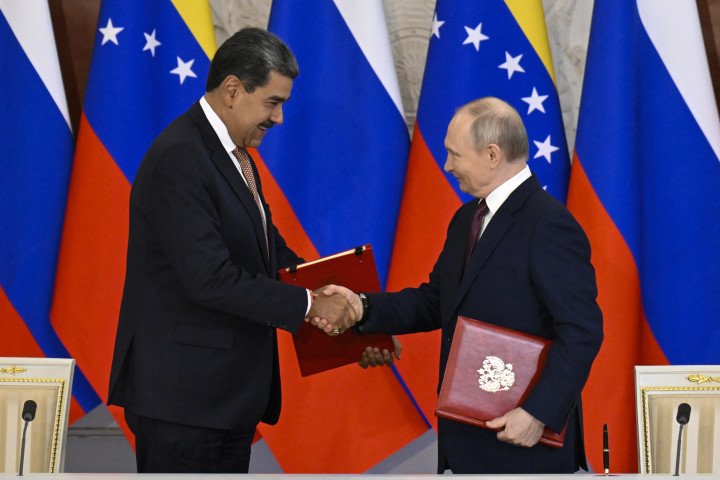
Russia’s propaganda operation in Latin America
Russia is actively engaged in disinformation operations across Latin America, spreading pro-Kremlin narratives, favourable to its invasion of Ukraine.
Russian state media like RT and Sputnik—banned in Europe for spreading pro-Kremlin narratives—continue to push articles framing Russia’s invasion as a “special military operation” to “denazify” Ukraine.
In 2024, US officials reported that Russia uses media networks to distribute disinformation in at least a dozen countries, including Argentina, Brazil, Chile, Colombia, Mexico, and Venezuela. The operation aims to reduce support for Ukraine and fuel anti-US and anti-NATO views.
Washington called the operation “influence-for-hire” and identified companies like the Social Design Agency (SDA ) as key players in these campaigns. Content is created in Russia and disseminated through local channels posing as independent journalism.
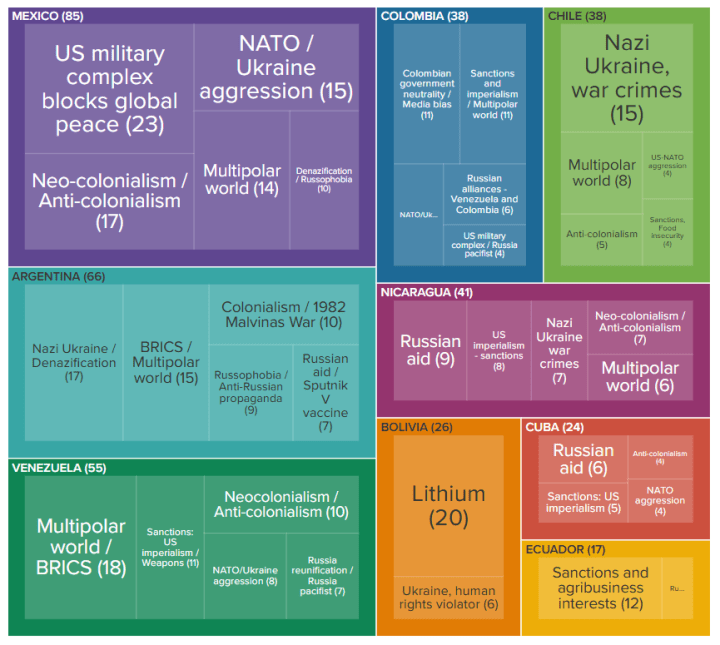
Russia tailors topics to each individual country. Russia’s war in Ukraine was the dominant topic in Brazil, according to the Digital Forensic Research Lab (DFRLab) report, Undermining Ukraine: How Russia widened its global information war in 2023. The Russian ambassador referred to the denazification of Ukraine in 176 statements while referring to other issues in fewer than 70.
DFRLab’s report found that 19 out of 38 statements by Russian diplomats in Chile portrayed Ukraine as the aggressor and responsible for war crimes. In Argentina, 17 out of 66 statements referred to Ukraine as a Nazi state and to the war as a denazification operation.
The report also found that the US was a victim of the propaganda campaign. In Mexico, Russian diplomats mentioned the “US complex blocking global peace” 23 times. “US imperialism sanctions” was also a hot topic in Colombia, Nicaragua, Cuba, and Venezuela. DFRLab found that there was a great emphasis on narratives criticizing Western military assistance to Ukraine, reinforcing the “proxy war” portrayal, as NATO waging war against Russia through Ukraine.
How does Russia’s relationship with Latin America undermine global democracies?
Russia and its Latin American allies mutually provide a shield against diplomatic issues.
Despite sanctions, Russia can assist the Global South in military and political support.
Russia is part of the United Nations Security Council and can veto efforts to hold countries accountable for human rights violations. In return, its Latin American Allies shield Russia from international isolation by providing diplomatic support, most recently, specifically in its invasion of Ukraine.
Russia’s intelligence and surveillance operations in Nicaragua allow Moscow to conduct cyber operations through the US and its Allies, potentially gaining access to information about operations in Ukraine.
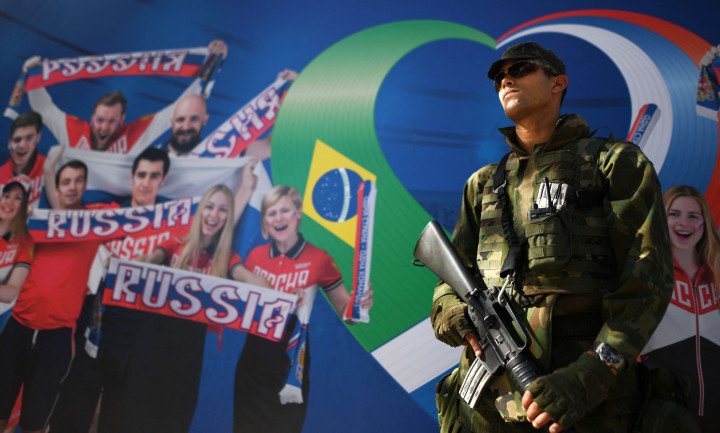
Since Russia’s full-scale invasion of Ukraine, it's difficult for Russian nationals to obtain visas to the UK and abroad. Traditional avenues Russia previously used to conduct its aggressive espionage operations have been shut down.
Instead, Moscow has been deploying “numerous people living innocuous lives” globally to spy for the Kremlin. An Argentinian couple, running an art gallery and an IT start-up, living in Slovenia. A Mexican-Greek photographer running a yarn shop in Athens. Reports claim that many spies arrested since 2022 have one thing in common: the Americas. Latin America remains the “springboard” for Russian spies globally.
As Russia deepens its ties in Latin America, it exports not only weapons, but its propaganda, opaque deals, and espionage.
-46f6afa2f66d31ff3df8ea1a8f5524ec.jpg)
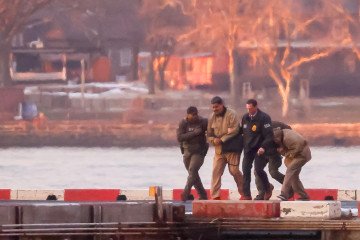
-29a1a43aba23f9bb779a1ac8b98d2121.jpeg)
-c9be02aad2c169e14ebc2a41d0ba02dc.jpg)
-605be766de04ba3d21b67fb76a76786a.jpg)
-56e0bfa71829348120777fba0ad5ba46.png)

